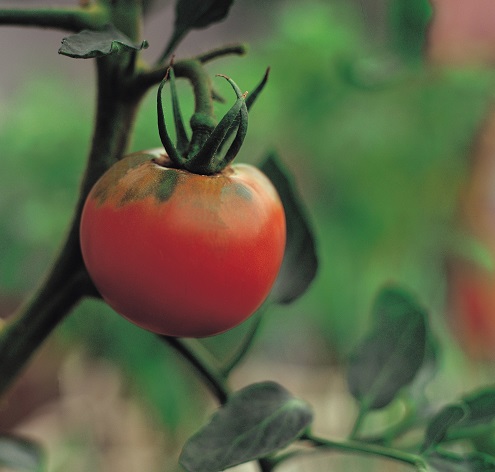
All summer long devoted gardeners look forward to picking the first juicy ripe tomato of the season. But occasionally those first tomatoes have soft brown or black leathery spots covering the bottom of the fruit. Or a lovely big tomato that has been ripening will suddenly develop a large crack and split open, or ugly rings will mar the fruit near the stem. Blossom end rot and splitting tomato problems are disappointing but common and can be prevented.
Blossom end rot is a tomato affliction that causes a leathery sunken spot on the bottom of the tomato fruit. The good news is that blossom end rot does not spread from one plant to another, nor does it affect the plant itself.
Blossom end rot is typically seen early in the season and usually doesn’t affect tomato fruit that is set later in the summer. The problem is caused by a poor supply of water and calcium in the developing tomatoes. Tomato plants that were planted in the garden before the soil warmed up are susceptible to blossom end rot problems because their root systems don’t develop well in cold soil. Without a good root system, the plants cannot take up enough moisture and calcium for the developing fruit, resulting in blossom end rot. Blossom end rot may also be a problem after dry periods followed by heavy rains.
Mulching your tomato-growing bed after the soil has warmed up is a good way to prevent blossom end rot. Mulch helps to prevent tomato problems because it aids in maintaining even moisture in the soil. You’ll also want to keep the plants well watered during dry periods and avoid cultivating too closely to the plants as this can disturb tiny feeder roots that are close to the surface. When planting tomatoes, some gardeners mix a handful of crushed eggshells into the planting hole to provide extra calcium to the plant and help avoid blossom end rot.
If you have tomatoes afflicted with blossom end rot, just remove those fruits from the plant, maintain even moisture for your plants and wait for the next set of tomatoes to ripen. Chances are that the next tomato to ripen will not have blossom end rot problems.
Of course every gardener would prefer to grow picture-perfect tomatoes, but it seems there are tomato problems throughout the growing season that can cause tomatoes to be less pretty than we’d like. After weeks of carefully tending tomato plants in anticipation of a bountiful crop, occasionally some tomatoes will develop splits or cracks just as they reach their peak ripeness.
It is quite common for tomatoes to split, and there are a couple of reasons for these tomato problems. Split tomatoes can be caused by either moisture or heat stress. Some varieties are more susceptible than others to these unsightly cracks. You may find tomatoes with large cracks that form concentric circles around the stem. This splitting is caused by moisture stress when the fruit becomes too plump too quickly and literally bursts through the skin. This type of cracking typically occurs after a heavy rainfall that follows a dry spell.
Large cracks on tomatoes that radiate down from the stem are caused by heat stress. This splitting occurs during periods of hot, bright sunlight and temperatures above ninety degrees. To help prevent tomato problems caused by moisture or heat stress, try to maintain even moisture for the plants and provide good drainage in the soil. A thick layer of mulch over the plants’ roots will help keep the soil cool and evenly moist. Remove ripe and nearly ripe fruit after a heavy rainfall before it has a chance to split. Tomatoes that are nearly ripe can be picked and allowed to finish ripening on the kitchen counter.
The splits and rings are cosmetic only and will not affect the flavor of the tomatoes. If the fruit is harvested immediately it will still be good for eating. But don’t let a tomato stay on the plant if it has split because it can easily be invaded by insects or slugs and over time mold can develop in the open cracks.
Mike McGroarty is the owner of McGroarty Enterprises and the author of several books. You can visit his website at Freeplants.com and read his blog at Mikesbackyardnursery.com.
Related Articles & Free Email Newsletter
How to Grow Juicy and Tasty Tomatoes
How to Identify & Control the Tomato Russet Mite




Comment here